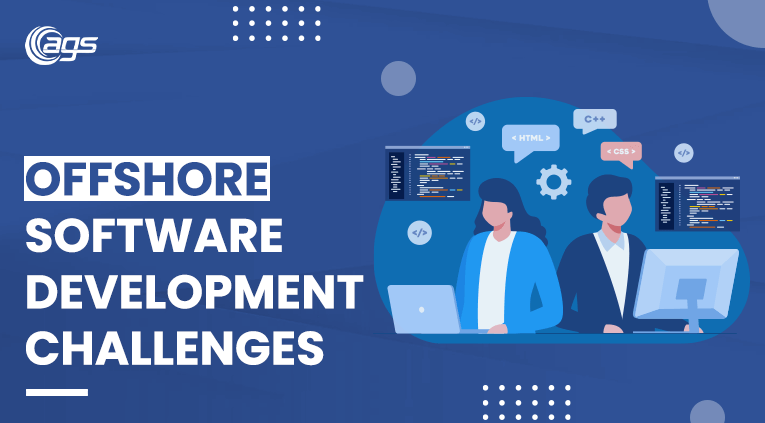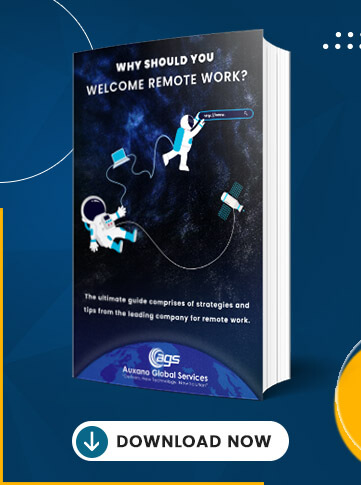Livestock farming is a multi-billion dollar industry across the globe. As a matter of fact, this sector holds a major share of the global agriculture GDP. Today, people use livestock products like meat, dairy, eggs, fiber, etc., on a day-to-day basis. To keep up with this hefty market demand, farmers often find themselves struggling with livestock management.
One way to streamline livestock and animal farming is to use a livestock management system. This system is a technology-based solution that automates, optimizes, and technologizes livestock management. However, how exactly can a software help with cattle and sheep management? If you have this question, make sure to read this blog carefully till the end.
In this blog, we have provided complete information on the use of software for livestock management. If you are someone from the agriculture and farming industry, this blog can be incredibly useful for you to understand the vast potential of such software.
Without further ado, let’s start the blog with the basic concepts and principles of livestock software.
Back to Basics: Fundamentals of Livestock Management Software
The farming and agriculture industry is vast, to say the least. There are numerous sub-sectors that fall under agriculture, one of which is animal farming. This type of farming requires dealing with ‘livestocks’, like sheep, cattle, buffalo, pigs, goats, etc. Basically, every animal that can be raised on a farm is a livestock animal.
Of course, managing this livestock requires the farm owners to invest additional time, resources, and capital. Despite these efforts, many farmers fail to raise their livestock optimally. Taking these challenges into account, it is now a popular practice to use a management software for livestock.
These type of software focus on using technology to automate livestock management from start to end. A livestock management system is a part of a bigger picture, which are farm management software- a market worth approximately USD 3 billion.
These software are enriched with numerous features and functionalities that laser-focus on improving the quality of livestock and maximizing yield. Not just that, these software have numerous other benefits. The coming section will shed light on these benefits in detail.
Benefits of Using a Cattle Management System
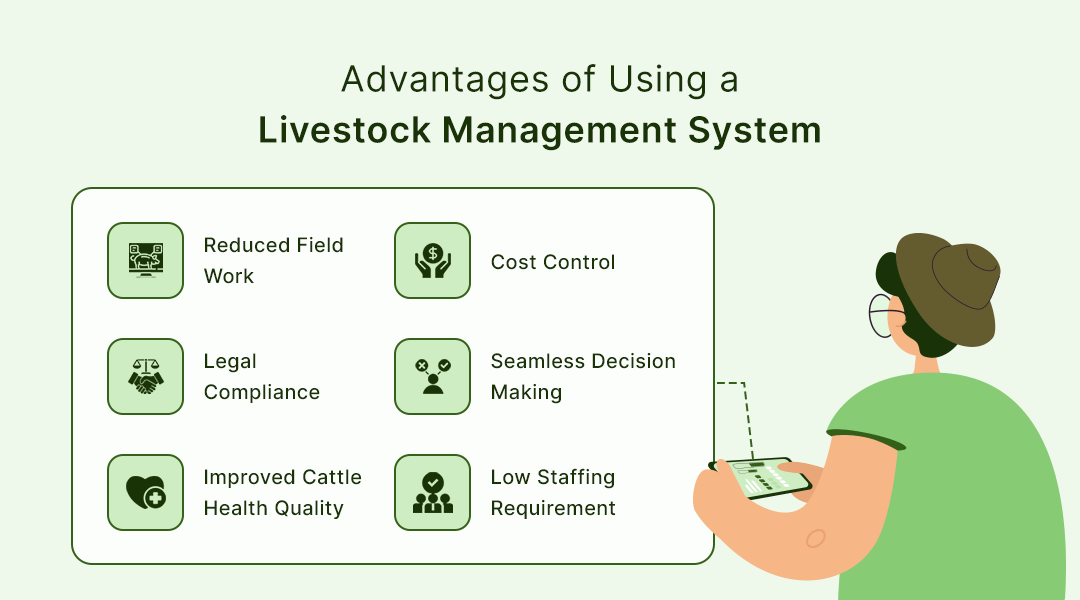
A software solution can seamlessly revolutionize farm and livestock management. These software are capable of conducting tasks that are second-to-impossible with manual processes.
Moreover, with a software, you can provide better care to your livestock, directly benefiting your business. Let’s discuss some remarkable benefits of a livestock management software application.
1. Reduced Field Work
Managing livestock can be a tedious process. This is especially the case if you are operating a large-scale farm with numerous types and species of livestock. Each animal requires special and unique care, making it challenging for farm owners to provide optimal care. In the end, these farm owners have to spend a plethora of time in the fieldwork, taking care of each type of livestock.
Livestock management systems, on the other hand, can be extremely useful in this matter. These systems are capable of automating monotonous tasks that require less brain work. Therefore, by using this software, you will be spending less time on the field. In the end, you will be left with more time to focus on your core business activities.
2. Cost Control
High operational costs are one of the major challenges that come with livestock farming. This is because maintaining livestock comes with numerous expenses related to animal feed, healthcare, etc. However, these expenses are mandatory for maintaining optimal livestock quality. The better your livestock’s health will be, the better products you will yield.
In this case, using a livestock management system can be a great idea for controlling costs. These systems can be used to optimize livestock expenses by using data to understand requirements. This way, livestock farmers can eliminate unnecessary expenses and improve their overall profitability.
To add to that, livestock management technology also enables farmers to source their feed from the best and most competitive sellers. This way, you can further reduce the cost of livestock management and increase business profitability.
3. Legal Compliance
Raising livestock requires complying with numerous laws and legal regulations. Doing so is often challenging for people working in the farming industry. This is because complying with these regulations requires additional time and effort. However, this aspect of livestock farming is non-negotiable and cannot be compromised.
This is another reason why more and more livestock farmers are using a management system for cattle and other livestock. This system, based on numerous software and hardware integrations, ensures that your farming processes comply with legal requirements.
This usually includes requirements related to the livestock’s health, feed quality, farming conditions, product quality, etc. Moreover, this software can also take care of other legal requirements like animal registration, pedigree, farmer’s licenses, and more. In the end, you can use this software to practice ethical and legally sound livestock farming.
4. Seamless Decision Making
Making robust and error-free decisions is another common challenge in livestock farming. Most livestock farmers often find themselves unable to make the right decisions at the right time. This can negatively impact their overall productivity. However, proper decision-making is essential for optimal farm administration and management.
In this case, it is a great idea to use a herd management system. These software solutions are capable of understanding, analyzing, processing, and turning data into useful information. This information is then used by the software to make robust decisions. In the end, these software come in handy when livestock farmers fail to make the right decisions for their business.
5. Improved Cattle Health Quality
A livestock management system can be integrated with numerous technologies like wearables and IFRD. These technologies make it possible for livestock farmers to monitor the cattle’s health seamlessly at all times. Briefly put, livestock wearables are capable of monitoring various health vitals like body temperature, O2 levels, heart rate, etc.
These software informs the farm owner in case of any issues in the cattle’s health. This enables the farmer to ensure that the livestock receives the right treatment on time, further improving their quality of life.
Moreover, you can also integrate your livestock management system with ambiance monitoring technologies like thermostats, humidity monitors, etc., to further ensure optimal living conditions for your livestock. In the end, the better your livestock’s health will be, the better products you will get.
6. Low Staffing Requirement
Managing a livestock farm comes with tremendous human resource requirements. Farm owners not only need to spend additionally on these human resources but also need to ensure that these resources are working optimally. This idea can be infeasible when it comes to large-scale livestock farming. However, one great solution to this problem is to use a software to automate processes.
In the previous section, we discussed how having a software for cattle management can help you automate processes. Naturally, the more processes you automate, the less work you will have to do. At a larger level, software automation can help you reduce your overall staffing requirements.
This is because these software are growing smarter each day. In the end, you can use them as a safe replacement for human resources and reduce your staffing requirements. This benefit of a farm software is especially noteworthy and can even reduce your overall human resource investments.
By now, we are sure that you know the benefits of using a software solution for livestock management. Moving forward, we will be discussing the use cases of such software. Doing so will help us understand the ways in which you can harness the benefits mentioned above.
Use Cases of a Livestock Management System
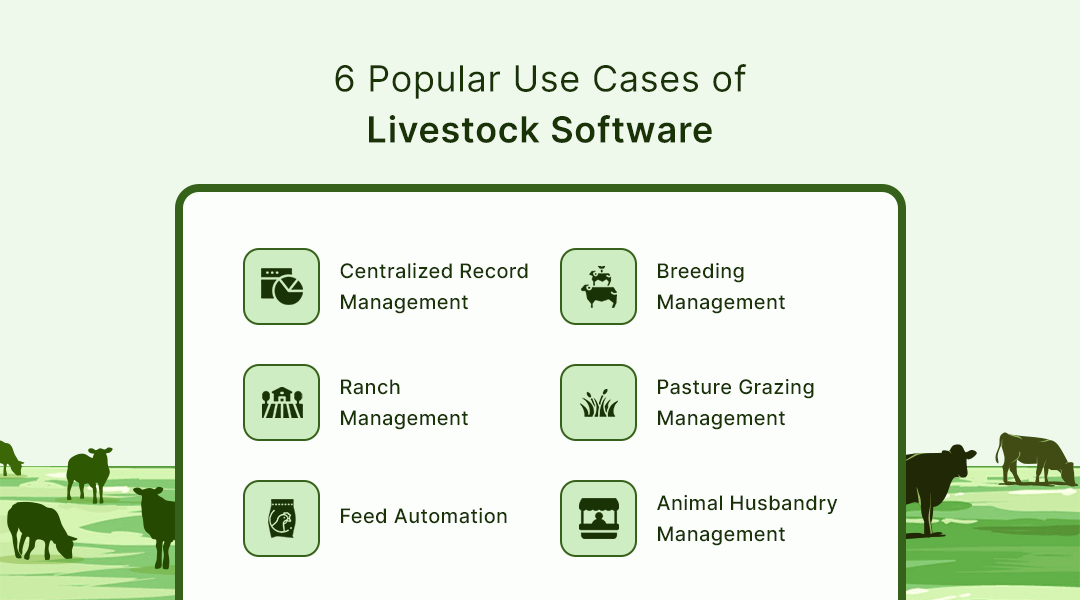
It is essential to understand the exact uses of a herd management system. Doing so can help you understand the software’s applications in day-to-day livestock farming. Here, we have discussed some of the most common use cases of such software.
Do note that there are numerous other use cases that depend on your family’s unique requirements. We recommend that you consult with a software expert to know the exact use cases of a cattle management system.

Nevertheless, we can go ahead and discuss the common use cases of such software.
1. Centralized Record Management
Precisely maintaining records and documents can often be a challenge for livestock farmers. However, doing so is highly important. Moreover, many legal bodies require livestock farmers to maintain optimal documentation for their livestock, including registration certifications, vaccine documents, vital signs, etc.
A cattle management software application is a one-stop database management solution. This software is often used to centrally and digitally store and share all livestock-related information. With centralized record management, livestock farms can avoid manual documentation, which is usually prone to human errors.
You can use this software to remotely access all the information and even share it with other people. To add to that, you can stay assured of the information’s integrity since livestock systems are known for their security.
2. Breeding Management
A major part of raising livestock is managing the animals’ breeding. This often involves tracking fertility, ensuring optimal breeding conditions, and monitoring pregnancy. A cattle management software is excellent in this aspect. These software makes it possible for livestock farmers to get real-time reproductive status on the livestock and seamlessly track its pregnancy.
Enriched with wearables and mobile integration, these software are a one-stop solution for breeding management. This aspect of livestock management software is usually useful for cattle, buffalo, horses, pigs, etc.
Moreover, do note that gene editing is becoming popular in livestock breeding. These software enable livestock farmers and biotechnologists to seamlessly enable gene editing and improve livestock quality, further aiding business growth.
3. Ranch Management
Managing ranches requires tremendous effort. One has to oversee the complete operations of the farm, including the animals’ health, well-being, feed, and more. A livestock management system is useful in this case and can help ranch managers do all these tasks smoothly and remotely.
Thanks to this software, ranch management is now easier than ever before. You can use this software to manage ranch budgets, cattle and livestock, track sales, maintain inventory, and do a lot more. Briefly put, a cattle management software solution is a one-stop platform for complete ranch management. Moreover, if you plan to lease out your ranch, this software can also help you manage leasees and digitalize bookkeeping.
4. Pasture Grazing Management
Precisely controlling animal grazing is important to successfully run a livestock farm. With that being said, there is no better way to ensure an optimal grazing environment for animals than using a digital management system for livestock. This system enables farm owners to ensure optimal grazing conditions for the animals.
This includes ensuring that enough graze is available to the livestock during the grazing period. In this aspect, the livestock software is often integrated with the farm management system. This is because ensuring optimal grazing conditions requires maintaining adequate soil conditions, temperature, nutrients, etc. An effective software can help farm owners reduce their spending on cattle feed and maximize grazing.
5. Feed Automation
While it is true that grazing is the food source for most animals, it might not always be enough. There are numerous cases where animals need additional feed to fulfill nutritional requirements. In this case, livestock farmers are required to manage this additional feeding apart from grazing.
Here, you can use a custom livestock management software to automate feed management. This part of the software automatically calculates the feed requirement of an animal. This calculation is based on factors like their body weight, activity levels, nutrition requirements, etc.
This software can also be integrated with other hardware technologies to automatically mix, dispense, and distribute the feed. This way, you can largely automate feed management and maintain optimal grazing for the livestock.
6. Animal Husbandry Management
The primary purpose of raising livestock is to produce animal products like meat, eggs, dairy, fiber, leather, etc. Managing this produce is a challenge in itself, as most farmers struggle to determine the optimal yield of their livestock.
However, with a livestock management system, you can largely optimize animal husbandry and ensure optimal yield. This is possible through the smart tracking technology that these software offer. Not just that, you can also use these software to practice selective breeding and improve the overall produce quality.
These were a few use cases of a cattle management software in day-to-day livestock farming. Now that you know the benefits and uses of a livestock management software solution, it is time to go ahead and learn how to implement this software. This will be our topic for the coming section.
Process of Implementing a Livestock Management Software
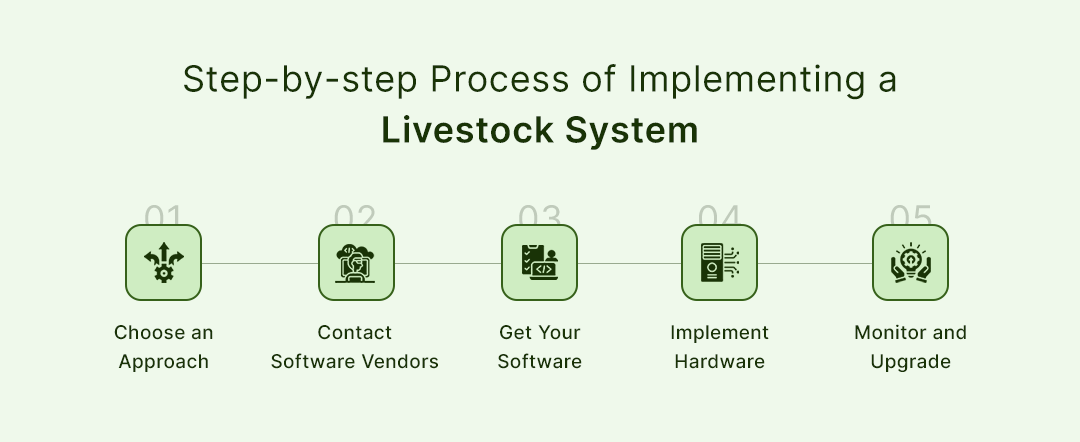
So far, we have covered the benefits and use cases of cattle software. Now that you know why exactly it is a good idea to use such software, you must be wondering, ‘how exactly do I implement a software solution for livestock management?‘ Let’s discuss the step-by-step process of doing so and understand how we can fully leverage a software to manage cattle.
Step #1: Choose an Approach
The first and foremost step to implementing a livestock management software solution is choosing the type of software you want to use. Primarily speaking, there are two options here- custom cattle management software and readymade cattle management software.
1. Custom Solution
A custom livestock management software is a tailor-made software solution built specially for your business. Everything in this software, from features to hardware integration and functionalities, is custom-made to fit your business needs. Naturally, you can choose to add or eliminate certain features to scale your software with your business.
2. Readymade Solution
A readymade livestock management system is a SaaS-based product that can be readily implemented into your business. As their name suggests, these software are readily available solutions sold by IT vendors. You can purchase one of these solutions and digitalize livestock management.
In case you are unaware of which of these solutions will be ideal for your business, take a look at the below-given comparison:
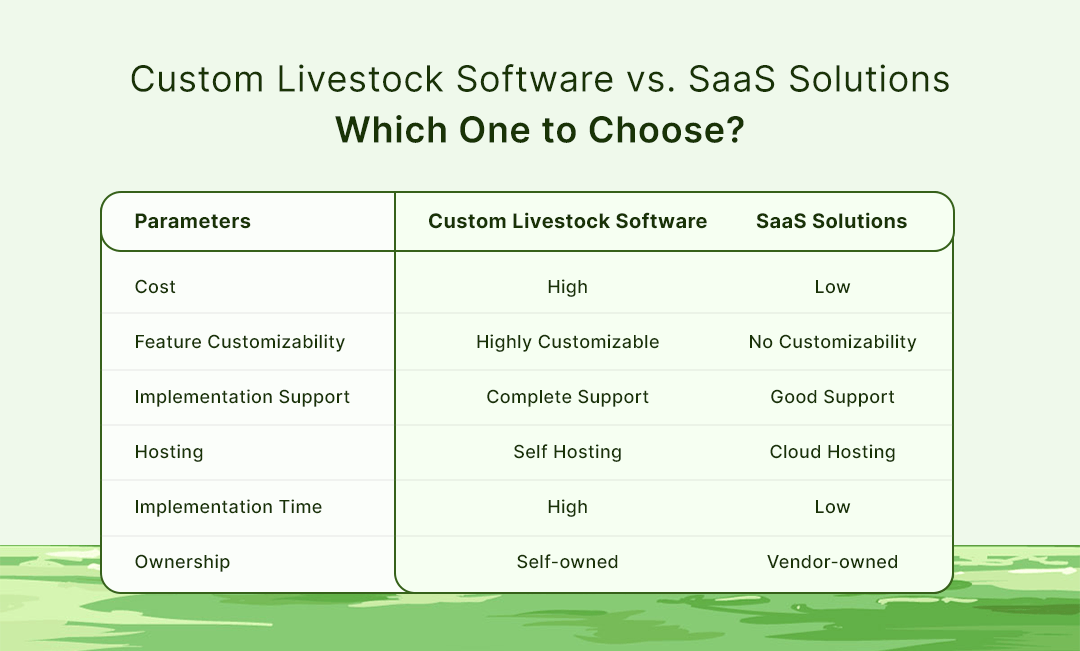
Once you have decided which type of software solution you need for livestock management, you can go ahead and contact the vendors to get your software.
Step #2: Contact Software Vendors
Depending on the type of software you require, you can choose the vendor of your choice. In case you need a custom herd management software, you need to contact a livestock management software development company. These vendors, based on your requirements, will custom-develop a software for your livestock’s management. Of course, this can be a time and capital-demanding process.
On the other hand, for SaaS-based cattle systems, you can contact numerous SaaS solution providers. These solution providers offer their ready-to-use SaaS solutions on a subscription basis.
Do note that it is essential to choose the right vendor for your software. We recommend that you choose an experienced custom software engineering vendor like Auxano Global Services and ensure optimal domain expertise for guaranteed success.

Step #3: Get Your Software
Once you have found the right vendor for your software solution and have built the software of your choice, you can go ahead and implement it. The exact process of implementing a software depends on the vendor chosen in the previous stage. Different approaches have different implementation methods.
Nevertheless, whether you go with custom cattle management software or purchase a readymade solution, you can stay assured that you will get thorough implementation support from the chosen vendor. This implementation support will help you fully implement the software into your business.
Step #4: Implement Hardware
Once you have implemented the software architecture of your livestock management system, you can go ahead and implement the hardware. This involves implementing IoT sensors and other devices.
Generally speaking, the most commonly used hardware technologies in livestock management are animal wearables and sensor-based monitors. These technologies are then integrated with a software to enable seamless interoperability. By the end of this stage, you will be ready to fully harness the benefits of your cattle management software solution.
Step #5: Monitor and Upgrade
Once you have implemented the software, you can go ahead and use it for cattle management. However, the process does not end here. If you have opted for custom livestock management software, you will need periodic maintenance. This step involves adding new features and functionalities to the software.
Doing so will help you to ensure that your software is performing optimally and is at par with your livestock business’s changing requirements. Upgradation and maintenance is an essential part of livestock management software development. However, do note that if you opt for readymade solutions, the vendor will take care of this part. As a result, you will have to depend on the SaaS solution provider to start using new features.
This is it for the process of implementing a management software for livestock. You can use this information and get the right software for your livestock farming business. However, it is important to note that livestock technology is not static. There have been numerous noteworthy technological advancements in livestock management. The coming section will shed light on a few of these advancements.
Next-gen Technologies in Livestock Management Systems
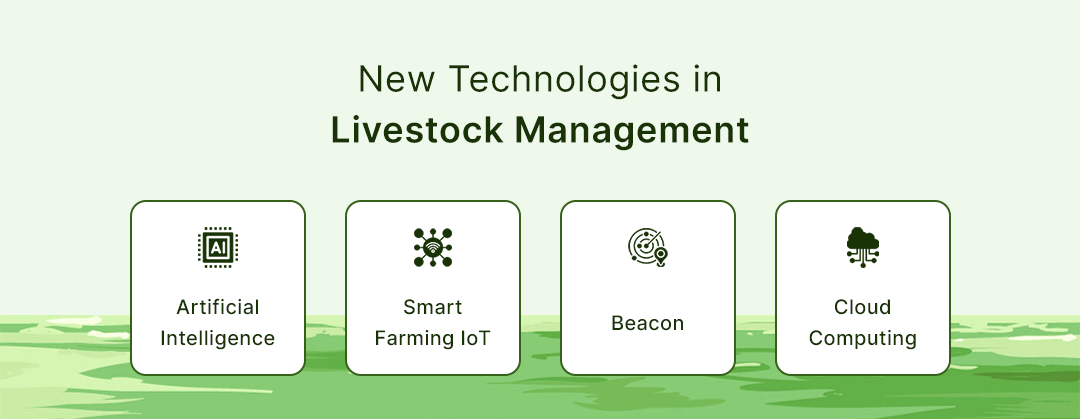
There is no doubt that using a software solution for cattle management has numerous advantages. Moreover, thanks to the latest tech innovations, these advantages are more prominent than ever before. Here, we have discussed the top 5 technologies that can be used with a livestock management system for better cattle management. Make sure to read carefully, as this section will help you change your livestock management game.
1. Artificial Intelligence
The AI technology is known for being smart, precise, and efficient. These 3 factors are widely sought after in the livestock farming industry. Owing to this factor, more and more livestock farmers are looking for ways to integrate their software with AI technology.
An AI-based cattle management software application can help livestock farmers predict numerous critical aspects of cattle farming. This includes advanced health diagnosis, weather conditions, produce and yield, etc.
The livestock farmers can use these smart predictions for numerous important decisions like cattle vaccination, feed management, and more. Not just that, AI can help livestock farmers make numerous important decisions related to cattle farming for improved farming efficiency.
2. Smart Farming IoT
Earlier in this blog, we discussed how the Internet of Things is a critical aspect of livestock farming technology. Livestock wearables, health monitors, and farm condition trackers are just a few of the many uses of IoT.
When using a management software for cattle, you can implement IoT-based hardware for many more purposes. Simply put, IoT serves as a 360-degree ecosystem that nurtures complete farming and agriculture technologization.
You can use IoT-based devices to maintain and upkeep all aspects of your farming business. From produce tracking to temperature management and grazing, IoT is useful in all aspects of livestock farming. Not only that, you can also use IoT for soil monitoring, fish farming, and more. This proves the wide scope of smart IoT systems in the agriculture industry.
3. Beacon
Managing livestock animals is a huge challenge for cattle farmers. This is especially the case with large-scale farms with numerous types of animal species. Due to this reason, more and more farming businesses are using beacon technology. Based on BLE, beacons can be revolutionary for livestock farming.
Beacons are devices that can be integrated with a livestock management system and used for geofencing. In lay terms, beacons enable livestock farmers to create digital fences. When an animal crosses this fence, a notification is raised in the software. This way, livestock farmers can ensure that all the animals are within the farm’s premises.
4. Cloud Computing
Thanks to the growing popularity of cattle management systems, it is now possible for farmers to digitalize record keeping. However, just digitally storing these records is not enough for livestock management digitalization. This data needs to be accessible remotely for optimal efficiency.
This is the reason why more and more livestock farmers are integrating their software with cloud computing technology. This technology enables livestock farmers to digitally store, share, and process their business information.
With cloud-integrated farm software, farmers can seamlessly share livestock information with other people. This usually involves sharing information with healthcare service providers, government offices, etc.
Final Thoughts: Livestock Management Software
A livestock management software solution is an excellent medium to digitalize livestock management. These software enable livestock farmers to automate and optimize numerous aspects of raising livestock.
With this blog, you can understand the benefits of using a cattle system for your farm’s management. Moreover, in this blog, we have also covered the use cases of these systems to help you better understand their applications.
By precisely identifying the use cases of these software and following the correct implementation process, you can harness all the advantages of livestock software solutions. All you need to do is find the right vendor for your software’s requirements with the right skills in livestock management system development.
Looking to Build a Livestock Management System?
Auxano Global Services is an industry-leading livestock management software development company offering cutting-edge software solutions. We hold 8+ years of expertise in offering custom-developed livestock management software application solutions.
Get in touch with us today to avail our livestock management system development services and build a cattle software with our team. You can send us your requirements at admin@auxanoglobalservices.com, and our team will get back to you with bespoke software solutions within 48 hours.





